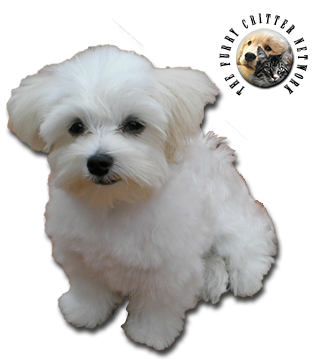Breed Standard
Head: Fairly broad. Flat skull. Very pronounced stop. Straight nosebridge. Thin lips. Large nose.
Ears: Set on high, pendulous, hanging against the sides of the head.
Eyes: Fairly large, dark ocher. Edge of eyelids black.
Body: Long. Withers protruding slightly from the topline. Chest well let-down. Straight back. Very broad and long, nearly level croup.
Tail: Thick at the base and thin at the tip. Forming a single large curve with the tip hanging between the hips and touching the croup.
Hair: Very long on the entire body, completely straight, without waves or curls. Silky. Hair on the trunk should be longer than the height at the withers and fall heavily to the ground. No undercoat. Very long on the head. Hair on the tail hangs on only one side of the trunk.
Coat: Pure white. Pale ivory allowed. Traces of pale orange highlights are tolerated, as long as they resemble soiled hairs, but they are a flaw.
Size: Dog: 21 to 25 cm.Bitch: 20 to 23 cm.
Weight: 3 to 4 kg.
History
The Maltese is a very old breed with hotly debated origins. This little dog's ancestors hunted pests in the ports and maritime cities of the central Mediterranean. It is certain that this dog or a similar breed existed in ancient Egypt and Greece and later in Rome. The ancient Greek geographer Strabon reported that the Sicilian city of Melita exported dogs called canes meliteris. Even though the Maltese is named after Malta, there is no proof that he is a native of this island. Prized by nobility, he was a favorite of England's royal court under Queen Elizabeth I.
Behavior
Affectionate: Maltese dogs are often deeply attached to their owners and enjoy spending time cuddling and being close to them.
Playful: Despite their small size, Maltese dogs are often quite playful and enjoy interactive games and toys.
Alert: Maltese dogs tend to be alert and aware of their surroundings. They may bark to alert their owners of any potential intruders or unusual activities.
Intelligent: Maltese dogs are generally intelligent and can be quick learners. However, they may also have a stubborn streak, so consistent and patient training is essential.
Social: Maltese dogs typically enjoy being around people and may get along well with other pets if properly socialized from a young age.
Sensitive: Maltese dogs can be sensitive to changes in their environment or routine. They may require gentle handling and may become anxious if left alone for long periods.
Vocal: Maltese dogs have a tendency to bark, which can be a way of expressing themselves or alerting their owners. Proper training can help manage excessive barking behavior.
Lap dogs: Maltese dogs often enjoy sitting on their owner's lap or being carried around. They thrive on human companionship and may seek out close physical contact with their owners.
Understanding these behavioral traits can help owners provide appropriate care, training, and socialization to ensure that their Maltese companion is happy and well-adjusted.
Health
Prone to sunburn along the hair parting, skin, eye issues, respiratory, and slipped stifle. Some may be difficult to feed with weak, upset digestion. They may get the chills, and they experience discomfort in hot weather. Maltese should be kept out of damp areas. Also prone to teeth problems. Feeding dry dog biscuits in addition to their normal food can help the teeth stay clean and healthy.






